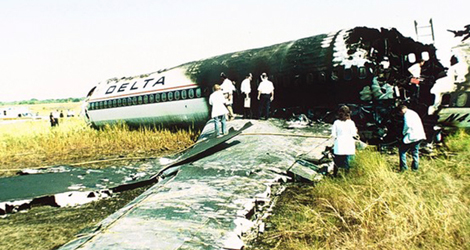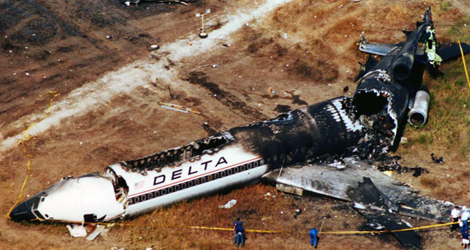About 0901 central day light time on August 31, 1988, Delta Airlines flight DL1141 crashed shortly after lifting off from runway 18L at the Dallas-Fort Worth International Airport Texas.
The airplane, a Boeing 727 -232 , U. S. Registry N473DA, was a regularly scheduled passenger flight and was en route to Salt Lake City ,Utah, with 101 passengers and 7 crew members .
Delta Airlines flight DL1141 crew reported that the take off roll appeared to be normal in all aspects, with no warning lights, audible warnings , or unusual engine instrument conditions .
The captain stated that the rotation was initially normal , but as the main gear wherels left the ground he heard “two explosions.” He said it felt as though the air plane was experiencing “reverse thrust.”
The captain of Delta Airlines flight DL1141 stated that the airplane began to “roll violently. “

Delta Airlines flight DL1141
Delta Airlines flight DL1141 struck the instrument landing system (ILS) localizer antenna array approximately 1,000 feet beyond the end of runway 18L , and came to rest about 3,200 feet beyond the departure end of the runway.
The flight was airborne approximately from lift off to the first ground impact near the ILS localizer antenna. The airplane was destroyed by impact forces and the post crash fire.
Of the persons on boardDelta Airlines flight DL1141 , 14 passengers and 2 crew members were killed , 21 passengers and 5 crew members were seriously injured ,and 68 passengers sustained minor or no injuries.
The National Transportation Safety Board determines that the probable cause of this accident to be
- the Captain and First Officer’s inadequate cockpit discipline which resulted in the flight crew’s attempt to take off without the wing flaps ands slats properly configured ; and
- the failure of the take off configuration warning system to alert the crew that the airplane was not properly configured for the take off.
Contributing to the accident was Delta’s slow implementation of necessary modifications to its operating procedures, manuals, checklists, training, and crew checking programs which was necessitated by significant changes in the airline following rapid growth and merger.
Also contributing to the accident was the lack of sufficiently aggressive action by the FAA to have known deficiencies corrected by Delta and the lack of sufficient accountability with in the FAA’s air carrier inspection process.
Download Report


What became of the captain, Larry Lon Davis, and the first officer, Carey W. Kirkland, Jr., who both survived and apparently still happily amongst the living? Wasn’t there some information released following the disaster about the f.o. flirting with a flight attendant just prior to the takeoff roll? Thank you. . .
I’m not sure about the pilot, but the F.O. is alive and well, albeit a couple inches shorter than before. He’s a flight instructor for one of the Phenom jets at the moment, but he’s trying to retire.
The first officer seems to be a flying instructor
The Captain and First Officer were fired by Delta. The Flight attendant they were flirting with was killed in the crash.
They weren’t flirting, just conversing, which of course was still problematic as the conversation violated the FAR for Sterile Cockpit. We had sat on the taxiway for over 30 minutes waiting for ATC to deal with other flights. At the time, these lengthly delays were routine in DFW, which created an overly-complacent and obviously unsafe working environment. The 2nd Officer Judd was (appropriately, IMO) ultimately rehired by DAL. Because F/O Kirkland lost consciousness upon impact, he couldn’t qualify for a Class 1(at least that was the regulation at that time) I believe he was subsequently granted a medical retirement.